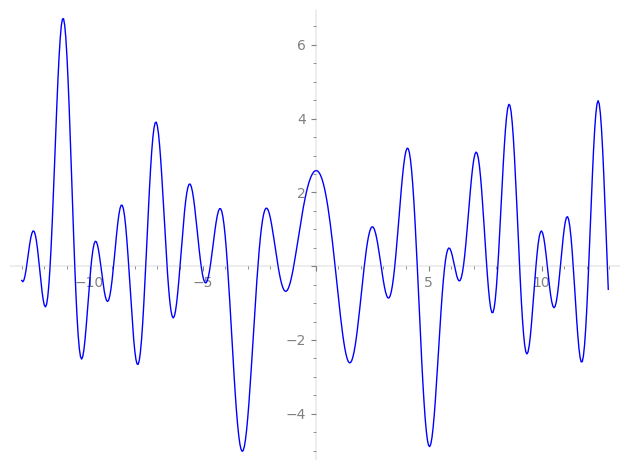| L(s) = 1 | + (1.94 − 3.37i)5-s + (2.18 + 3.78i)11-s + (−0.792 + 1.37i)13-s + 5.33·17-s − 4.64·19-s + (0.183 − 0.318i)23-s + (−5.07 − 8.79i)25-s + (5.08 + 8.81i)29-s + (1.14 − 1.98i)31-s + 10.8·37-s + (0.690 − 1.19i)41-s + (3.81 + 6.61i)43-s + (−3.80 − 6.58i)47-s + 0.925·53-s + 17.0·55-s + ⋯ |
| L(s) = 1 | + (0.870 − 1.50i)5-s + (0.659 + 1.14i)11-s + (−0.219 + 0.380i)13-s + 1.29·17-s − 1.06·19-s + (0.0383 − 0.0664i)23-s + (−1.01 − 1.75i)25-s + (0.944 + 1.63i)29-s + (0.206 − 0.357i)31-s + 1.78·37-s + (0.107 − 0.186i)41-s + (0.582 + 1.00i)43-s + (−0.554 − 0.961i)47-s + 0.127·53-s + 2.29·55-s + ⋯ |
Λ(s)=(=(5292s/2ΓC(s)L(s)(0.928+0.371i)Λ(2−s)
Λ(s)=(=(5292s/2ΓC(s+1/2)L(s)(0.928+0.371i)Λ(1−s)
| Degree: |
2 |
| Conductor: |
5292
= 22⋅33⋅72
|
| Sign: |
0.928+0.371i
|
| Analytic conductor: |
42.2568 |
| Root analytic conductor: |
6.50052 |
| Motivic weight: |
1 |
| Rational: |
no |
| Arithmetic: |
yes |
| Character: |
χ5292(1765,⋅)
|
| Primitive: |
yes
|
| Self-dual: |
no
|
| Analytic rank: |
0
|
| Selberg data: |
(2, 5292, ( :1/2), 0.928+0.371i)
|
Particular Values
| L(1) |
≈ |
2.589920816 |
| L(21) |
≈ |
2.589920816 |
| L(23) |
|
not available |
| L(1) |
|
not available |
L(s)=p∏Fp(p−s)−1 | p | Fp(T) |
|---|
| bad | 2 | 1 |
| 3 | 1 |
| 7 | 1 |
| good | 5 | 1+(−1.94+3.37i)T+(−2.5−4.33i)T2 |
| 11 | 1+(−2.18−3.78i)T+(−5.5+9.52i)T2 |
| 13 | 1+(0.792−1.37i)T+(−6.5−11.2i)T2 |
| 17 | 1−5.33T+17T2 |
| 19 | 1+4.64T+19T2 |
| 23 | 1+(−0.183+0.318i)T+(−11.5−19.9i)T2 |
| 29 | 1+(−5.08−8.81i)T+(−14.5+25.1i)T2 |
| 31 | 1+(−1.14+1.98i)T+(−15.5−26.8i)T2 |
| 37 | 1−10.8T+37T2 |
| 41 | 1+(−0.690+1.19i)T+(−20.5−35.5i)T2 |
| 43 | 1+(−3.81−6.61i)T+(−21.5+37.2i)T2 |
| 47 | 1+(3.80+6.58i)T+(−23.5+40.7i)T2 |
| 53 | 1−0.925T+53T2 |
| 59 | 1+(0.460−0.797i)T+(−29.5−51.0i)T2 |
| 61 | 1+(3.27+5.67i)T+(−30.5+52.8i)T2 |
| 67 | 1+(7.50−12.9i)T+(−33.5−58.0i)T2 |
| 71 | 1−4.91T+71T2 |
| 73 | 1−7.56T+73T2 |
| 79 | 1+(0.987+1.71i)T+(−39.5+68.4i)T2 |
| 83 | 1+(−0.253−0.438i)T+(−41.5+71.8i)T2 |
| 89 | 1−12.2T+89T2 |
| 97 | 1+(−4.45−7.71i)T+(−48.5+84.0i)T2 |
| show more | |
| show less | |
L(s)=p∏ j=1∏2(1−αj,pp−s)−1
Imaginary part of the first few zeros on the critical line
−8.266897219230684081090315462929, −7.51467560706438317602817537490, −6.57086193760047084163211043304, −5.99745402260862591804948063610, −5.06048257605267736581024313889, −4.65906679062242654198244971451, −3.89405363794656840669277229520, −2.55114032450808069368796815980, −1.65876900884437433584702086088, −0.967597710416652193236394051550,
0.864595929329807412601138768252, 2.15560738196045678047673368989, 2.90072491885599893619297567392, 3.50427417011230386875216486448, 4.49962889139576392205181393986, 5.71527150977619267520991763859, 6.14761854583483919240322108383, 6.54148589494891498467609808109, 7.57308337770889711317870029681, 8.063740219149057541313030307357

